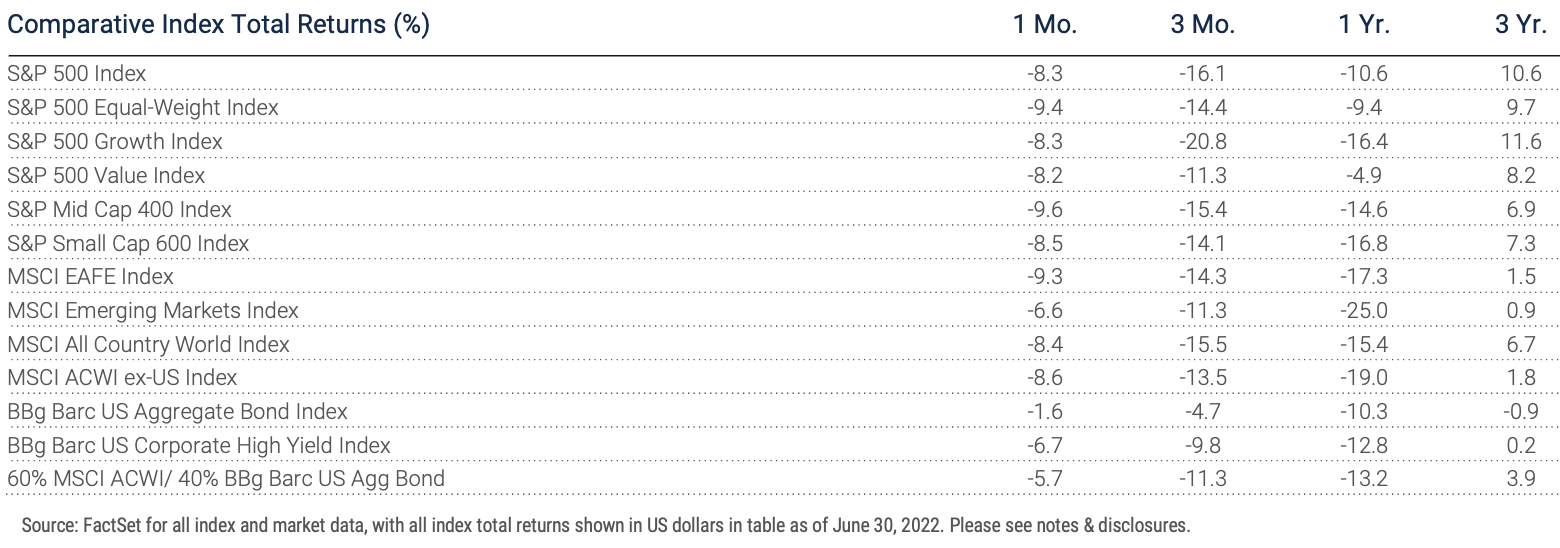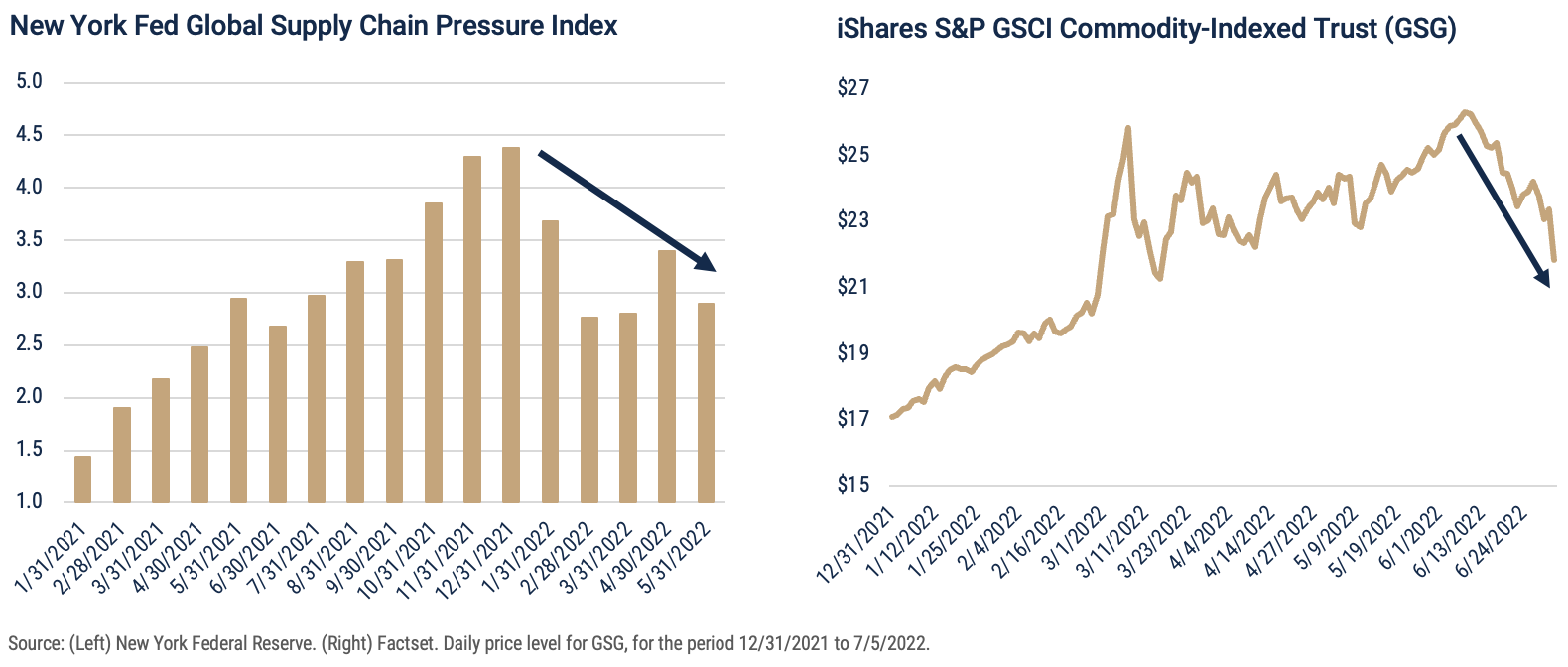June 2022 | Global Equity Markets Review
After a strong finish in May producing slight positive returns for the month, the selling resumed in June resulting in the second weakest month of a forgettable year so far. The S&P 500 total return in June was -8.25% while the S&P Mid Cap 400 and S&P Small Cap 600 trailed with returns of -9.62% and -8.54%, respectively. The selling was broad based with more than 6.6 decliners for every stock up in the month. Cyclical stocks weighed heavily on the market benchmarks as fear of a recession supplanted inflation as investor’s primary concern. The Energy sector, the lone standout performer year to date, led the market lower across all market capitalizations. Value stocks, which carry a higher weight in economically sensitive stocks, underperformed growth stocks with the Russell 3000 Growth Index returning -7.82% while the value counterpart was -8.81%. June’s pattern between the major styles was an interruption in what has been a relatively better run for value driven equities.

With inflation top of mind for investors, the search is on for rays of sunshine which might indicate a peak in prices. Two important measures are the New York Federal Reserve Global Supply Chain Pressure Index and the iShares GSCI Commodity-Indexed Trust. We have highlighted both measures in the graphs below. Supply chains are still recovering from COVID-related disruptions and are analogous to the time it takes to clear a traffic jam caused by an accident. Fed Chair Jerome Powell cited the extended snarling of supply chains last December when he admitted inflation was not as “transitory” as the Fed first thought. The good news from the graph on the left, supply chain pressure peaked in December and has been heading lower as of the last data point in May. More progress can be expected as China emerges from their lockdown and the further we get from the maximum pressure point. The graph on the right is a commodity-based index trust which has shown a tight relationship to interest rates. The sharp rise in interest rates in response to high inflation levels have also been a major hurdle for stocks to overcome. Energy makes up 67% of the weight in this trust with Agriculture, Industrial Metals, Livestock and Precious Metals comprising the remainder. This security reached a 2022 high on June 8th and has since declined 17% over the past three weeks. Long-term interest rates took their cue from this inflation data point and declined meaningfully over the same period taking downward pressure off stock market valuation measures. These two inflation indicators will be important to monitor in the coming weeks and months.

Global equity markets responded in kind to the sharp drop in U.S. stock prices last month. The S&P Global Developed ex-U.S. Index had a return of -10.11% in June with the Global Emerging Index returning -5.80%. Developed European markets were weakest as the added inflationary impact of the conflict in Ukraine was felt more acutely. China was the most positive contributor to emerging market bourses as the lifting of COVID related shutdowns motivated investors sitting on the sidelines to reallocate to the biggest emerging market. Asia has become an increasingly important part of emerging market indexes and arguably stands to benefit the most from the removal of supply chain blockages. The U.S. dollar was up 2.9% in June and has been on a strong run from its July 2021 low. Dollar strength by many measures, while understandable in the short run, appears increasingly unsustainable when viewed from a longer perspective. Inflation is a global phenomenon as is the response by global central banks coordinating to raise rates and lower inflation. Success on this front should disproportionately benefit non-U.S. markets through a combination of a softer U.S. dollar after its extended move and better valuation characteristic in international markets.
Notes & Disclosures
Index Returns – all shown in US dollars
All returns shown trailing 6/30/2022 for the period indicated. “YTD” refers to the total return as of prior-year end, while the other returns are annualized. 3-month and annualized returns are shown for:
- The S&P 500 index is comprised of large capitalized companies across many sectors and is generally regarded as representative of US stock market and is provided in this presentation in that regard only.
- The S&P 500® Equal Weight Index (EWI) is the equal-weight version of the widely-used S&P 500. The index includes the same constituents as the capitalization weighted S&P 500, but each company in the S&P 500 EWI is allocated a fixed weight - or 0.2% of the index total at each quarterly rebalance. The S&P 500 equal-weight index (S&P 500 EWI) series imposes equal weights on the index constituents included in the S&P 500 that are classified in the respective GICS® sector.
- The S&P 500 Growth Index is comprised of equities from the S&P 500 that exhibit strong growth characteristics and is weighted by market-capitalization.
- The S&P 500 Value Index is a market-capitalization weighted index comprising of equities from the S&P 500 that exhibit strong value characteristics such as book value to price ratio, cash flow to price ratio, sales to price ratio, and dividend yield.
- The Russell 3000 Index tracks the performance of 3000 U.S. corporations, determined by market-capitalization, and represents 98% of the investable equity market in the United States.
- The Russell Mid Cap Index measures the mid-cap segment performance of the U.S. equity market and is comprised of approximately 800 of the smallest securities based on current index membership and their market capitalization.
- The Russell 2000 Index is a market-capitalization weighted index that measures the performance of 2000 small-cap and mid-cap securities. The index was formulated to give investors an unbiased collection of the smallest tradable equities still meeting exchange listing requirements.
- The MSCI All Country World Index provides a measure of performance for the equity market throughout the world and is a free float-adjusted market capitalization weighted index.
- The MSCI EAFE Index is a market-capitalization weighted index and tracks the performance of small to large-cap equities in developed markets of Europe, Australasia, and the Far East.
- The MSCI Emerging Markets Index is a float-adjusted market-capitalization index that measures equity market performance in global emerging markets and cannot be purchased directly by investors.
- The S&P Global BMI sector indices are into sectors as defined by the widely used Global Industry Classification Standards (GICS) classifications. Each sector index comprises those companies included in the S&P Global BMI that are classified as members of respective GICS® sector. The S&P Global BMI Indices were introduced to provide a comprehensive benchmarking system for global equity investors. The S&P Global BMI is comprised of the S&P Emerging BMI and the S&P Developed BMI. It covers approximately 10,000 companies in 46 countries. To be considered for inclusion in the index, all listed stocks within the constituent country must have a float market capitalization of at least $100 million. For a country to be admitted, it must be politically stable and have legal property rights and procedures, among other criteria.
- The Barclay’s US Aggregate Index, a broad-based unmanaged bond index that is generally considered to be representative of the performance of the investment grade, US dollar-denominated, fixed-rate taxable bond market.
- The Bloomberg Barclay’s US Corporate High Yield Index, which covers the USD-denominated, non-investment grade, fixed-rate, taxable corporate bond market.
An index is a portfolio of specific securities, the performance of which is often used as a benchmark in judging the relative performance to certain asset classes. Index performance used throughout is intended to illustrate historical market trends and performance. Indexes are managed and do not incur investment management fees. An investor is unable to invest in an index. Their performance does not reflect the expenses associated with the management of an actual portfolio. No strategy assures success or protects against loss. There is no guarantee that a diversified portfolio will enhance overall returns or outperform a non-diversified portfolio. Diversification does not protect against market risk. All investing involves risk including loss of principal. Investing in stock includes numerous specific risks including: the fluctuation of dividend, loss of principal, and potential liquidity of the investment in a falling market. Past performance is no guarantee of future results.
Key Indicators
Key Indicators correspond to various macro-economic and rate-related data points that we consider impactful to equity markets.
- The US 10-Year Treasury Yield (%)/bps, is the return on investment for the U.S. government’s 10-year debt obligation and serves as a signal for investor confidence.
- SPDR Gold Trust Price ($), is an investment fund that reflects the performance on the price of a gold bullion, less the Trust’s expenses.
- West Texas Intermediate, which is an oil benchmark and the underlying asset in the New York Mercantile Exchange’s oil futures contract.
- CBOE Volatility Index (Level)/% Change, which uses price options on the S&P 500 to estimate the market's expectation of 30-day volatility.
General Disclosure
Wilbanks, Smith & Thomas Asset Management (WST) is an investment adviser registered under the Investment Advisers Act of 1940. Registration as an investment adviser does not imply any level of skill or training. The information presented in the material is general in nature and is not designed to address your investment objectives, financial situation or particular needs. Prior to making any investment decision, you should assess, or seek advice from a professional regarding whether any particular transaction is relevant or appropriate to your individual circumstances. This material is not intended to replace the advice of a qualified tax advisor, attorney, or accountant. Consultation with the appropriate professional should be done before any financial commitments regarding the issues related to the situation are made.
This document is intended for informational purposes only and should not be otherwise disseminated to other third parties. Past performance or results should not be taken as an indication or guarantee of future performance or results, and no representation or warranty, express or implied is made regarding future performance or results. This document does not constitute an offer to sell, or a solicitation of an offer to purchase, any security, future or other financial instrument or product. This material is proprietary and being provided on a confidential basis, and may not be reproduced, transferred or distributed in any form without prior written permission from WST. WST reserves the right at any time and without notice to change, amend, or cease publication of the information. The information contained herein includes information that has been obtained from third party sources and has not been independently verified. It is made available on an "as is" basis without warranty and does not represent the performance of any specific investment strategy.
Some of the information enclosed may represent opinions of WST and are subject to change from time to time and do not constitute a recommendation to purchase and sale any security nor to engage in any particular investment strategy. The information contained herein has been obtained from sources believed to be reliable but cannot be guaranteed for accuracy.
Besides attributed information, this material is proprietary and may not be reproduced, transferred or distributed in any form without prior written permission from WST. WST reserves the right at any time and without notice to change, amend, or cease publication of the information. This material has been prepared solely for informative purposes. The information contained herein may include information that has been obtained from third party sources and has not been independently verified. It is made available on an “as is” basis without warranty. This document is intended for clients for informational purposes only and should not be otherwise disseminated to other third parties. Past performance or results should not be taken as an indication or guarantee of future performance or results, and no representation or warranty, express or implied is made regarding future performance or results. This document does not constitute an offer to sell, or a solicitation of an offer to purchase, any security, future or other financial instrument or product.
